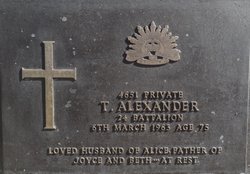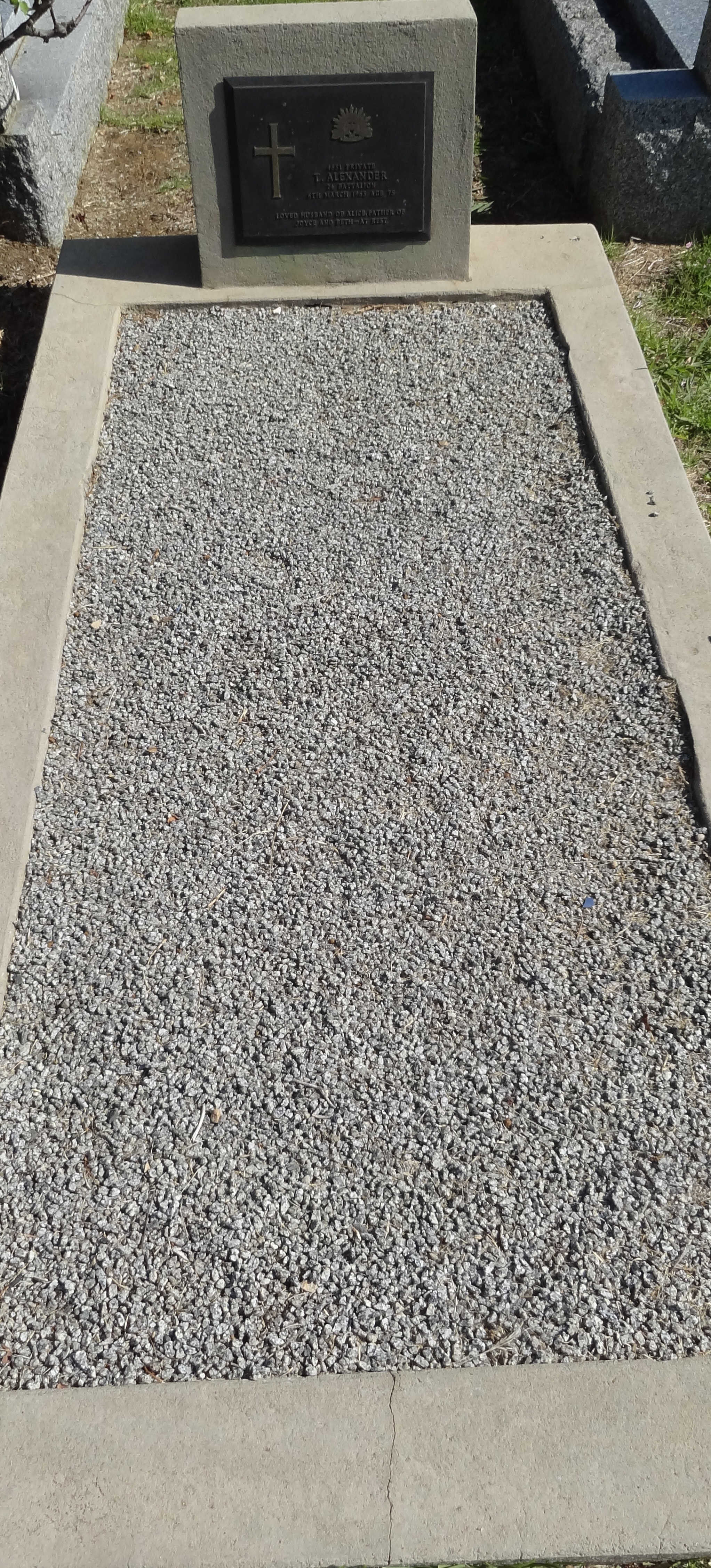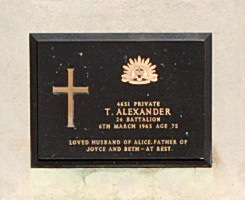Wounded in Action, Private, 4651, 24th Battalion, 12th Reinforcements
Thomas gave his occupation as Tram (Train?) Conductor and age as 28 years 2 months on the dated of signing his Attestation, March 7, 1916. He was a slight man, 5'6" weighing 9 stone 5.5 pounds, with a fresh complexion, grey eyes and dark brown hair. He was of the Catholic faith. He also had a few scars noted on his medical form. He advises his wife, Mrs. A Alexander, "Adelwood" 1 Warrigal Road, Oakleigh, Vic is his Next of Kin and also lists his father, John Alexander, New Street, Kew, Victoria.
Embarked 4th April 1916, H.M.A.T. "Euripides", joining the 24th Battalion, 12th Reinforcements, going from England to France and then to Belgium. He was admitted to C.C. Stn No 17 for Rheumatism where he spent 15 days from October 12 - Oct 27, 1916, before being declared "Fit" and "discharged to Base Details, Boulogne." Another bout of illness struck him on 10 November 1916 And he was admitted to 26th General Hospital with Myositis. He was transferred to 25th Gen. Hospital, Camiers with Orchitis on 24 Nov 1916. Finally transferred to No. 7 Conv Depot, Camiers on 16 December 1916, and from there, on December 27, 1916, discharged to base depot, Boulogne.
Pvt. Alexander rejoined the 24th Battalion on 26 January 1917. He was severely WOUNDED IN ACTION on 18 April 1917 by a mortar shell. He had a compound fracture of his left femur. He was treated at the field hospital and an operation was preformed to remove clothing from the wound. He was sent to the 13th General Hospital, Boulogne for three weeks and then transferred to the Queens (Civil) Gen. Hospital, Birmingham, England. He was there from 9 May 1917 until 12 February 1918 when we was transferred to 3rd Aux. Hospital, Dartford. On 16 March, 1918, he left England aboard the H.T. "Wandilla" to begin his journey back to Melbourne, being transferred to the H.S. "Kanowna" which left Suez on 15 April 1918 and arrived in Melbourne on 22 May 1918, more than one year after he was injured.
His wife, Alice and his father John, received information first that he was injured, hospital and severity unknown on May, 7, 1917, followed by a letter on 10 May 1917, stating he was suffering from a gun shot would of a dangerous nature. The first transfer to the hospital in Birmingham was reported to them and all other official correspondence reports read "still progressing favourably" with the last one being dated 11 December 1917.
According to medical history, this is what Pvt. Alexander went through:
Medical Report on invalid
February 23, 1918, No. 3 AAH Dartford, aged 29 on last birthday and had worked as a train conductor before entering the service.
Disability in respect to invaliding Shell Wound left leg (Fractured Femur)
Originally injured 18th April 1917, France.
"Was evacuated on above date with compound fracture of left femur. At C.C.S. 9 days, operated on for removal of clothing from wound.
2 days at 13th Gen. Hosp. Boulogne; Then Queens Hospital Birmingham 9 months, whilst in this hospital had 8 ops for removal of bone, etc.
Arrived in 3rd A.A.H. on 14th February."
Give your opinion as to the causation of the disability. "To service during the present war."
Present condition?
"Looks fairly well. Bone has united but position is very bad. Knee stiff. "3 1/2" shortening in left leg."
Recommend for discharge as permanently unfit and change to Australia.
No.3 Australian Auxilliary Hospital Dartford, 24 February 1918 and signed by the officer in charge of the case (illegible).
As part of his permanent record, and a follow-on of the above, a sheet titled "Opinion of the Medical Board" remarks state he was deemed 50% disabled for the purpose of pensions. It was also a "board finding" that he was "permanently unfit for both services." and discharge was not recommended, instead, "further treatment in hospital." The signatories of the Board on the letter are illegible as is the signature on the line of the stamp of the Surgeon General, dated 13 March 1918.
In a note, typed on the side of the "Opinion of the Medical Board" the following statement:
"Board Finding:Permanently unfit G.S. Unfit H.S. for 6 months. C2 5.3.1918. (Sgd) Chas Ryan, General."
NB: Another group of medical professionals noted his limb to be "useless" and suggested he was 75% disabled.
Another note left in his file:
No. 11 Australian General Hospital
AWL midnight July 10, 1918 til noon July 11, 1918 forfeit 1 days pay
Discharged September 12, 1918, medals mailed to Warncoort via Colac Vic signed T Alexander on 15 August 1923.
Wounded in Action, Private, 4651, 24th Battalion, 12th Reinforcements
Thomas gave his occupation as Tram (Train?) Conductor and age as 28 years 2 months on the dated of signing his Attestation, March 7, 1916. He was a slight man, 5'6" weighing 9 stone 5.5 pounds, with a fresh complexion, grey eyes and dark brown hair. He was of the Catholic faith. He also had a few scars noted on his medical form. He advises his wife, Mrs. A Alexander, "Adelwood" 1 Warrigal Road, Oakleigh, Vic is his Next of Kin and also lists his father, John Alexander, New Street, Kew, Victoria.
Embarked 4th April 1916, H.M.A.T. "Euripides", joining the 24th Battalion, 12th Reinforcements, going from England to France and then to Belgium. He was admitted to C.C. Stn No 17 for Rheumatism where he spent 15 days from October 12 - Oct 27, 1916, before being declared "Fit" and "discharged to Base Details, Boulogne." Another bout of illness struck him on 10 November 1916 And he was admitted to 26th General Hospital with Myositis. He was transferred to 25th Gen. Hospital, Camiers with Orchitis on 24 Nov 1916. Finally transferred to No. 7 Conv Depot, Camiers on 16 December 1916, and from there, on December 27, 1916, discharged to base depot, Boulogne.
Pvt. Alexander rejoined the 24th Battalion on 26 January 1917. He was severely WOUNDED IN ACTION on 18 April 1917 by a mortar shell. He had a compound fracture of his left femur. He was treated at the field hospital and an operation was preformed to remove clothing from the wound. He was sent to the 13th General Hospital, Boulogne for three weeks and then transferred to the Queens (Civil) Gen. Hospital, Birmingham, England. He was there from 9 May 1917 until 12 February 1918 when we was transferred to 3rd Aux. Hospital, Dartford. On 16 March, 1918, he left England aboard the H.T. "Wandilla" to begin his journey back to Melbourne, being transferred to the H.S. "Kanowna" which left Suez on 15 April 1918 and arrived in Melbourne on 22 May 1918, more than one year after he was injured.
His wife, Alice and his father John, received information first that he was injured, hospital and severity unknown on May, 7, 1917, followed by a letter on 10 May 1917, stating he was suffering from a gun shot would of a dangerous nature. The first transfer to the hospital in Birmingham was reported to them and all other official correspondence reports read "still progressing favourably" with the last one being dated 11 December 1917.
According to medical history, this is what Pvt. Alexander went through:
Medical Report on invalid
February 23, 1918, No. 3 AAH Dartford, aged 29 on last birthday and had worked as a train conductor before entering the service.
Disability in respect to invaliding Shell Wound left leg (Fractured Femur)
Originally injured 18th April 1917, France.
"Was evacuated on above date with compound fracture of left femur. At C.C.S. 9 days, operated on for removal of clothing from wound.
2 days at 13th Gen. Hosp. Boulogne; Then Queens Hospital Birmingham 9 months, whilst in this hospital had 8 ops for removal of bone, etc.
Arrived in 3rd A.A.H. on 14th February."
Give your opinion as to the causation of the disability. "To service during the present war."
Present condition?
"Looks fairly well. Bone has united but position is very bad. Knee stiff. "3 1/2" shortening in left leg."
Recommend for discharge as permanently unfit and change to Australia.
No.3 Australian Auxilliary Hospital Dartford, 24 February 1918 and signed by the officer in charge of the case (illegible).
As part of his permanent record, and a follow-on of the above, a sheet titled "Opinion of the Medical Board" remarks state he was deemed 50% disabled for the purpose of pensions. It was also a "board finding" that he was "permanently unfit for both services." and discharge was not recommended, instead, "further treatment in hospital." The signatories of the Board on the letter are illegible as is the signature on the line of the stamp of the Surgeon General, dated 13 March 1918.
In a note, typed on the side of the "Opinion of the Medical Board" the following statement:
"Board Finding:Permanently unfit G.S. Unfit H.S. for 6 months. C2 5.3.1918. (Sgd) Chas Ryan, General."
NB: Another group of medical professionals noted his limb to be "useless" and suggested he was 75% disabled.
Another note left in his file:
No. 11 Australian General Hospital
AWL midnight July 10, 1918 til noon July 11, 1918 forfeit 1 days pay
Discharged September 12, 1918, medals mailed to Warncoort via Colac Vic signed T Alexander on 15 August 1923.
Family Members
Sponsored by Ancestry
Advertisement
Records on Ancestry
Sponsored by Ancestry
Advertisement





